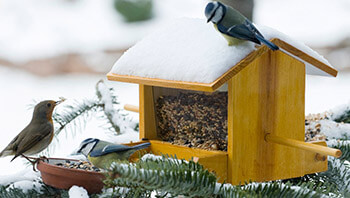Make Your Back Yard a Winter Destination for Birds
Oct 12, 2020

Many species of birds take up residence in our area during the winter months. Some species possess certain feeding habits and prefer particular types of feed, feeder, and shelter. Knowing which species visit and reside in your back yard this time of year will help you decide what to have readily available to make them feel at home.
Shelter
Ensure your back yard has lots of natural shelter such as native trees, shrubs, and ground cover. Evergreens, for example, provide plenty of warm roosting areas and provide a quick escape from predators. Trees such as oaks, dogwoods, and hollies provide plenty of high energy nuts and seeds. Ground-feeding birds prefer worms and other ground insects. For this reason, providing plenty of leaf mulch will ensure these little guys have a plentiful supply of healthy snacks.
Feeders
Tray feeders are ideal for many ground-feeding birds such as juncos, doves, robins, and jays. Place these feeders lower to the ground to make them attractive to these birds. Hopper feeders are preferred by finches, jays, cardinals, chickadees, and titmice. Hoppers hold a large quantity of feed; therefore, you fill them less often. Window feeders are great for getting a close-up view of these amazing creatures. This is especially helpful in educating children on bird identification. Tube feeders are the most common type of feeder. Smaller birds such as finches, chickadees, titmice, and sparrows are big fans of window and tube feeders.
Feed
There are many types of feed from which to choose. Suet cakes are a great high-energy snack favored by woodpeckers, nuthatches, chickadees, titmice, jays, and mockingbirds. Different types of seeds attract different types of birds. Sunflower seeds, whether black oil or grey-striped variety, also provide energy and will attract the widest variety of songbirds. There are also plenty of mixed seeds such as millet, milo, sunflower, corn, wheat, and other similar seeds. Specialty blends are also available for cardinals, finches, chickadees, and woodpeckers, just to name a few. Determine which birds are visiting your back yard and choose seed and suet types accordingly.
Your local Co-op stocks a wide variety of the feeders and feeds listed above. Feathered Friend brand bird food is in stock at many Co-op stores. Make sure to ask for it by name. Feathered Friend sunflower products are great for attracting the widest variety of birds. Feathered Friend Flyer’s Choice helps attract colorful birds such as cardinals and blue jays. Feathered Friend also offers specialty blends such as Cardinal’s Choice, Chickadee’s Choice, Finch Delight, Woodpecker’s Pick, and High-Energy Fruit and Nut. If you’re looking for a great all-purpose economical blend, Feathered Friend Favorite or Co-op Wild Bird Blend are great options.
Providing the right feeder, feed, and seed, along with fresh water (a birdbath is a great option) will help you be on your way to having a back yard that’s a winter vacation destination for birds.
Shelter
Ensure your back yard has lots of natural shelter such as native trees, shrubs, and ground cover. Evergreens, for example, provide plenty of warm roosting areas and provide a quick escape from predators. Trees such as oaks, dogwoods, and hollies provide plenty of high energy nuts and seeds. Ground-feeding birds prefer worms and other ground insects. For this reason, providing plenty of leaf mulch will ensure these little guys have a plentiful supply of healthy snacks.
Feeders
Tray feeders are ideal for many ground-feeding birds such as juncos, doves, robins, and jays. Place these feeders lower to the ground to make them attractive to these birds. Hopper feeders are preferred by finches, jays, cardinals, chickadees, and titmice. Hoppers hold a large quantity of feed; therefore, you fill them less often. Window feeders are great for getting a close-up view of these amazing creatures. This is especially helpful in educating children on bird identification. Tube feeders are the most common type of feeder. Smaller birds such as finches, chickadees, titmice, and sparrows are big fans of window and tube feeders.
Feed
There are many types of feed from which to choose. Suet cakes are a great high-energy snack favored by woodpeckers, nuthatches, chickadees, titmice, jays, and mockingbirds. Different types of seeds attract different types of birds. Sunflower seeds, whether black oil or grey-striped variety, also provide energy and will attract the widest variety of songbirds. There are also plenty of mixed seeds such as millet, milo, sunflower, corn, wheat, and other similar seeds. Specialty blends are also available for cardinals, finches, chickadees, and woodpeckers, just to name a few. Determine which birds are visiting your back yard and choose seed and suet types accordingly.
Your local Co-op stocks a wide variety of the feeders and feeds listed above. Feathered Friend brand bird food is in stock at many Co-op stores. Make sure to ask for it by name. Feathered Friend sunflower products are great for attracting the widest variety of birds. Feathered Friend Flyer’s Choice helps attract colorful birds such as cardinals and blue jays. Feathered Friend also offers specialty blends such as Cardinal’s Choice, Chickadee’s Choice, Finch Delight, Woodpecker’s Pick, and High-Energy Fruit and Nut. If you’re looking for a great all-purpose economical blend, Feathered Friend Favorite or Co-op Wild Bird Blend are great options.
Providing the right feeder, feed, and seed, along with fresh water (a birdbath is a great option) will help you be on your way to having a back yard that’s a winter vacation destination for birds.